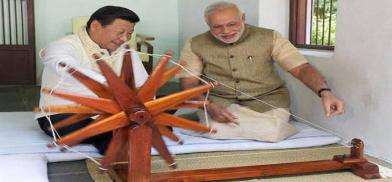Spinning the wheel of hope on October 2
India may be considering itself a regional power but is still far from being a global power

India may be considering itself a regional power but is still far from being a global power. After the end of the Cold War of the 20th century and unipolar hegemony of the US at the beginning of the 21st century, the world is witnessing China’s emergence as an economic and military power. It is an open secret that most of the countries would not like to see that happen, even if China fits well in the traditional definition of a superpower, having military prowess, potent economy and veto power in the UN Security Council. India has none of these.
Instead, though fully aware of the perils of democracy, India has demonstrated an impressive ability in the fields of information and communication technology (ICT) and is called by many as a knowledge power. Experts confirm that India’s knowledge power is not just limited to ICT. Indian communities gain strengths from traditional knowledge and nature-based solutions. It is still a largely agricultural country. It not only harbours pervasive poverty but also widespread inequality. Its free and politically-motivated media makes India’s real virtues dormant and its knowledge power weak.
Still, India remains a respected country in the world, not only because of its knowledge power but also its reputation of being a militarily and economically non-aggressive country. Above all, it is well known to have drawn its moral strength from the Father of Nation, Mahatma Gandhi, and its philosophical teachings derived from Bhagavad Gita, one of the world’s most influential, widely read scriptures, to seek the true meaning of existence. It took Mahatma like Gandhi to distil the teaching of non-violence from the Bhagavad Gita that justified a righteous war to subdue evil.
Invoking India's ancient philosophy
India needs to invoke its ancient and timeless philosophy today while dealing with our northern neighbour who now widely conceived as intriguing, untrustful and aggressive. What India needs is the resurrection of the old camaraderie that was displayed over countless meetings between Indian Prime Minister Narendra Modi and Chinese President Xi Jinping and use that to resolve current disagreements and challenges that have cropped between the countries. Disagreements should never be allowed to become disputes and then dog-fights. Modern diplomatic hawks do not like the dispute settlements even if they are in the national interest. Former Indian prime minister Atal Bihari Vajpayee is on record saying that one could change one's friends but not neighbours. Surely, one can change one's timeworn tactics with neighbours to resolve differences and restore friendliness.
Prime Minister Narendra Modi and Chinese President Xi Jinping have met at least 18 times since 2014 when Modi became prime minister for the first time. They visited each other’s home towns, Ahmedabad and Xi’an, in 2014 and 2015. Most of the other meetings they held were in the margins of international summits.
Two countries have been living since 1947, cautiously, with disagreements. However, to be fair, both the countries, at the same time, have been giving up on certain long-standing thorny issues. For example on one of the thorny issues of India of giving shelter to Dalai Lama, India had recognised Tibet as China’s integral part. There was friction over China blocking India’s entry into the Nuclear Suppliers Group as well as on Beijing’s refusal to back India’s attempts to get Pakistan-based militant Maulana Masood Azhar named a terrorist. India has opposed President Xi’s initiative on the Belt and Road Initiative and shown its concerns on China’s expansionism in the South China Sea. China has been extremely wary of the growing closeness between India and the US against the backdrop of its trade wars with the US. India is extremely displeased on the China-Pakistan Economic Corridor whereas China is not happy with quadrilateral (Quad) cooperation between US, Japan, India and Australia in the Indo-Pacific region. India and China both are worried about the infrastructure they are building for the troop movements on their respective sides.
Revive informal summit
However, what made global powers sit up and take notice were two innovative - and perhaps threatening to an extent - 'informal' meetings between Modi and Xi in Wuhan, China in April 2018 and in Mamallapuram, India in October 2019. The first one took place after more than two months' standoff between Chinese and Indian troops in Doklam plateau high in the Sikkim Himalayas. The second one took place two months before the novel coronoavirus started spreading all over the world. Innovative, because informal summits like these without agenda and aides are rare in 21st century diplomacy. Threatening, because such a 'friendship' between two leaders of the two largest and emerging economies sent shock waves around the world.
What these two leaders agreed in those two informal meetings was even earth-shaking to other global powers. As per the statement by Ministry of External Affairs of India, after one of the meetings, Modi and Xi agreed that “India and China, as major powers with decisional and strategic autonomy, will pursue peaceful stable and balanced relations and such a relationship will be a positive factor for stability in the current global uncertainty." They also agreed that the “development of a sound bilateral relationship which has about 40% of the world population will also be conducive for development in the region.” The two countries agreed to respect each other’s sensitivities and to maintain peace on the border.
Modi and Xi also agreed that “it is important to maintain peace and tranquillity in all areas of the India-China border region, and to this end, the two leaders decided that they would issue strategic guidance to their respective militaries to strengthen communication to build trust and understanding, to implement various confidence-building measures which have already been agreed upon by the two sides, and to strengthen existing institutional mechanisms to prevent and manage situations in the border areas”. Both countries even made a grand plan to celebrate the 70th anniversary of the establishment of the diplomatic relations by organising 70 events. Even the list was made ready in a short time.
What is difficult to understand for many diplomats however is the absence of any hotline mechanisms in case of sensitive situations that could trigger the spark on the borders. Informal one-to-one meetings - if used for one-off purposes - can often bring solutions but to modern diplomacy, they appear naïve.
Just about six months after an informal meeting in Mamallapuram in India, the border conflict started in the east of Ladakh. It can be described as the border war amidst borderless COVID19. Before the conflict, both countries were seen to be helping each other for COVID19 related treatments.
Invoking Gandhi
Mahatma Gandhi just before and during World War II wrote two letters to Adolf Hitler. He knew that Hitler was symbolic of brute force and aggressive power, and writing a letter to him was naïve. However, as a non-violent resister, Gandhi felt duty-bound to appeal to Hitler because, as a human being, Hitler too had the capacity to distinguish truth from falsehood.
He addressed Adolf Hitler as ‘Dear Friend’ and wrote on June 23, 1939, “ It is quite clear that you are today the one person in the world who can prevent a war which may reduce humanity to the savage state. Must you pay that price for an object however worthy it may appear to you to be? Will you listen to the appeal of one who has deliberately shunned the method of war not without considerable success?”. That letter certainly appeared to be naïve as Gandhi was no Mahatma then and did not belong to any government. He also knew that his letter would not be delivered by colonial powers.
On 2nd October, the birth anniversary of Mahatma Gandhi, is it naïve to expect from two leaders, Modi and XI, to talk one-to-one over telephone, with due respect yo each other’s sensitivity and territorial integrity, and then seek a peaceful solution? Is it naïve to think that as a Prime Minister of the country that carried Buddhist scriptures across the Himalayas to China to teach Buddhism there, he should be the first to call the President of China? Is it naïve to think that Modi should remind Xi of the spinning wheel that both together turned to spin the cotton thread in the Sabarmati Ashram of Mahatma Gandhi in Ahmedabad symbolising peace and non-violence? Is it naïve to think that the spinning wheel can be the new symbol of renewed hope and brotherhood between the two warring Asian powers?
(The writer is Chairman TERRE Policy Centre and former Director UNEP. The views expressed are personal)










Post a Comment